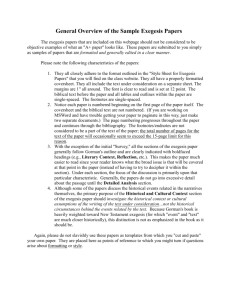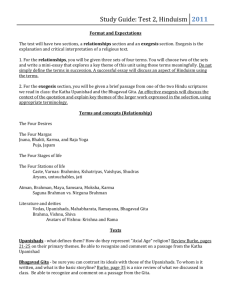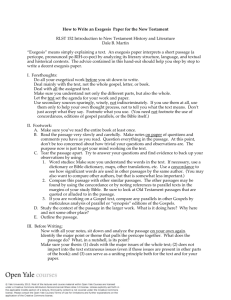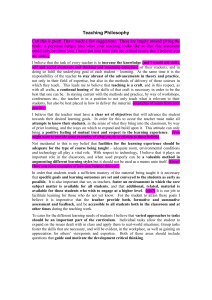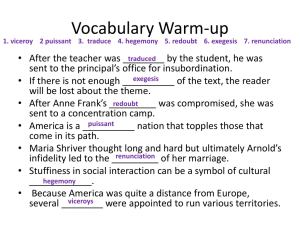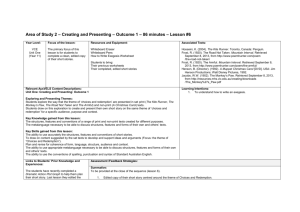One or Two Research Questions
advertisement
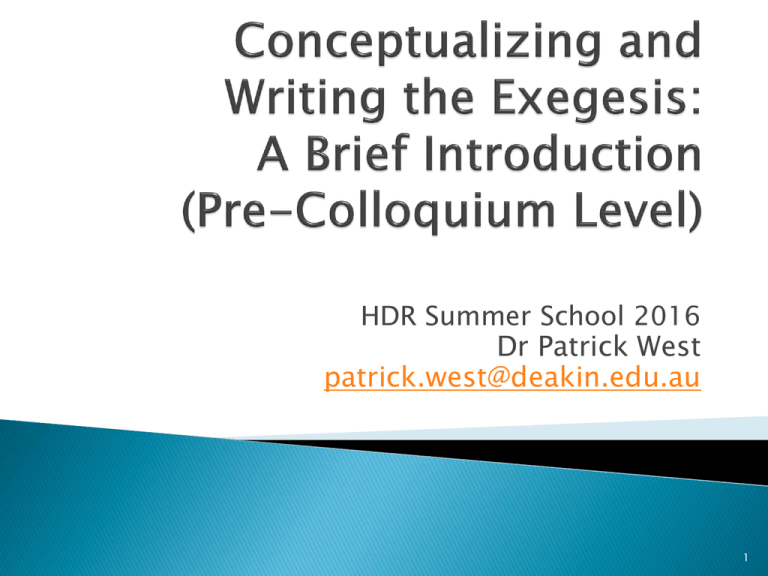
HDR Summer School 2016
Dr Patrick West
patrick.west@deakin.edu.au
1
The exegesis has always been with us in different
forms and under various names, yet it still puzzles
many writers and HDR students. This workshop will
provide an introduction to various models of the
exegesis, detail the different ways in which the
exegesis may be related to the creative product,
discuss examiners’ expectations of the exegesis, and
advise on how to guard against the most common
pitfalls of exegesis writing. The exegesis is an
exciting and constantly evolving mode of writing and
my hope is that participants will come to see how
they can work within the tradition of the exegesis
while shaping it to suit their own creative and
research purposes.
2
What is an exegesis?
3
What is an exegesis?
What is the relationship of the exegesis to the
creative product?
4
What is an exegesis?
What is the relationship of the exegesis to the
creative product?
What is the relationship of the exegesis and
the creative product to the research question?
5
What is an exegesis?
What is the relationship of the exegesis to the
creative product?
What is the relationship of the exegesis and
the creative product to the research question?
What should an exegesis do and how should
it do it?
6
What is an exegesis?
What is the relationship of the exegesis to the
creative product?
What is the relationship of the exegesis and
the creative product to the research question?
What should an exegesis do and how should
it do it?
How can we take advantage of the exegesis
as an evolving and creative mode of writing?
7
The HDR exegesis (plural, exegeses) is a piece of
moderately serious and detailed explanatory and/or
investigative writing that comments on and/or seeks
to explain the writer’s creative product and craft
and/or process and, together with the creative
product, forms an integral element of a thesis that
addresses a research question or questions.
Exegesis—from the Greek verb exegemai meaning ‘to
lead’, ‘to relate in detail’, ‘to expound’. (Biblical
Exegesis by John H. Hayes & Carl R. Holladay [John
Knox Press, 1982])
Exegesis— ‘(An) exposition, esp. of Scripture; a gloss,
an explanatory note or discourse.’ (The New Shorter
Oxford English Dictionary)
8
There is a long tradition of artists writing about
their creative work without necessarily using the
term ‘exegesis’.
Examples include: prefaces; introductions;
forewords; afterwords; author’s notes; footnotes.
Present-day understandings of the exegesis are
very much in flux and open to new interpretation
as they re-inflect this nest of examples.
Nigel Krauth, ‘The Preface as Exegesis’ TEXT 6:1,
April 2002 http://www.textjournal.com.au/april02/krauth.htm
9
It is not a ‘project statement’ or ‘statement of
intent’…
…it is written after the creative work not
before.
10
It is not a ‘project statement’ or ‘statement of
intent’…
…it is written after the creative work not
before.
It is not a piece of literary or arts criticism or
a review…
… it is written by the creative writer or arts
practitioner about their own work and takes
advantage of that fact.
11
It is not a ‘project statement’ or ‘statement of
intent’…
…it is written after the creative work not before.
It is not a piece of literary or arts criticism or a
review…
… it is written by the creative writer or arts
practitioner about their own work and takes
advantage of that fact.
It is not a piece of creative writing in itself…
… it is a piece of non-fiction writing (though
sometimes, perhaps, it can be in the creative
non-fiction mode or even, very rarely, it might
resemble a piece of creative writing itself).
12
1.) Context model:
2.) Commentary model:
3.) Research-Question model:
“rehearses the historical, social and/or disciplinary
context(s) within which the student developed the creative or production
component of her or his thesis.” Binary relationship; exegesis privileged
“an explication of, or comment on, the
creative production.” Binary relationship; creative work privileged
“In this model both the exegetical
and the creative component of the research thesis hinges on a research
question posed, refined and reposed by the student across the several stages
of a research program. Both the written and the creative component of the
thesis are conceptualised as independent answers to the same research
question” No binary; exegesis and creative work address the same researchquestion differently and equally
Barbara H. Milech & Ann Schilo, “‘Exit Jesus’: Relating the Exegesis and
Creative/Production Components of a Research Thesis” TEXT Special Issue 3, April
2004 http://www.textjournal.com.au/speciss/issue3/milechschilo.htm
13
1.) Research-Question Model*.
2.) Context Model.
3.) Commentary Model.
4.) Literary Criticism or Art Critical Model.
5.) Professional Model.
6.) Artist’s Statement Model.
7.) The Exegesis By Other Names Model
(Preface, Introduction, Author’s Note, Etc.)
* Our focus today is on model 1.)
14
The exegesis and the creative product jointly
address one or usually at least two research
questions using the affordances (possibilities
of relationship) that each part possesses.
15
The exegesis and the creative product jointly
address one or usually at least two research
questions using the affordances (possibilities
of relationship) that each part possesses.
The HDR candidate in the creative arts needs
to be able to answer this question: what does
my creative product allow me to say about my
research question that I wouldn’t otherwise
have been able to say?
16
The exegesis and the creative product jointly
address one or usually at least two research
questions using the affordances (possibilities of
relationship) that each part possesses.
The HDR candidate in the creative arts needs to
be able to answer this question: what does my
creative product allow me to say about my
research question that I wouldn’t otherwise have
been able to say?
The exegesis says things the creative product
can’t say, and vice versa. They speak and mean
differently. They have different voices.
17
Theses in the creative arts should address a
research question that would be
recognizable, in its form, to researchers in
the Humanities or Social Sciences as enabling
an original contribution to knowledge (craft
based or otherwise) building on previous
research.
18
Theses in the creative arts should address a
research question that would be recognizable, in
its form, to researchers in the Humanities or
Social Sciences as enabling an original
contribution to knowledge (craft based or
otherwise) building on previous research.
All theses in the creative arts inevitably answer at
least one research question (some question of
craft) precisely because they employ craft as their
research in the creation of the creative product.
19
Theses in the creative arts should address a
research question that would be recognizable, in
its form, to researchers in the Humanities or
Social Sciences as enabling an original
contribution to knowledge (craft based or
otherwise) building on previous research.
All theses in the creative arts inevitably answer at
least one research question (some question of
craft) precisely because they employ craft as their
research in the creation of the creative product.
Creative artists can learn more about their own
craft (knowledge transferable to themselves) by
observing how craft is used in any given thesis to
address a research question of whatever sort.
20
HDR students in the creative arts have an
important choice to make in their choice of a
principal research question.
21
HDR students in the creative arts have an
important choice to make in their choice of a
principal research question.
If they choose a principal research question
focused on craft then they have only one
principal research question to answer.
22
HDR students in the creative arts have an
important choice to make in their choice of a
principal research question.
If they choose a principal research question
focused on craft then they have only one
principal research question to answer.
If they choose a principal research question
unrelated to craft then they will necessarily be
answering two principal questions (the first of
non-craft and the second of craft).
23
HDR students in the creative arts have an
important choice to make in their choice of a
principal research question.
If they choose a principal research question
focused on craft then they have only one
principal research question to answer.
If they choose a principal research question
unrelated to craft then they will necessarily be
answering two principal questions (the first of
non-craft and the second of craft).
A craft-focused principal research question may
be either explicit or implicit.
24
Principal and secondary research questions
are related as aim is related to methodology.
25
Principal and secondary research questions
are related as aim is related to methodology.
The secondary research question is the
methodological question you need to answer
along the way to answering your principal
research question.
26
Principal and secondary research questions
are related as aim is related to methodology.
The secondary research question is the
methodological question you need to answer
along the way to answering your principal
research question.
This secondary or methodological research
question is always a form of: what do I have
to do in my creative product to answer my
principal research question?
27
Principal and secondary research questions are
related as aim is related to methodology.
The secondary research question is the
methodological question you need to answer
along the way to answering your principal
research question.
This secondary or methodological research
question is always a form of: what do I have to do
in my creative product to answer my principal
research question?
If your principal research question is already
about craft then your secondary research
question logically draws closer to your principal
research question.
28
Principal and secondary research questions are related as
aim is related to methodology.
The secondary research question is the methodological
question you need to answer along the way to answering
your principal research question.
This secondary or methodological research question is
always a form of: what do I have to do in my creative
product to answer my principal research question?
If your principal research question is already about craft
then your secondary research question logically draws
closer to your principal research question.
If your principal research question is not about craft then
your secondary research question also operates as a
second principal research question.
29
In drawing out what the creative product
offers by way of an answer to the principal
research question, the exegesis necessarily
reflects on the craft and/or process of the
creative product.
30
In drawing out what the creative product
offers by way of an answer to the principal
research question, the exegesis necessarily
reflects on the craft and/or process of the
creative product.
Craft is always in consideration either as a
means to answering a non-craft research
question or as the sole research question (as
in, a research question about craft theory or
the study of craft).
31
In drawing out what the creative product offers
by way of an answer to the principal research
question, the exegesis necessarily reflects on the
craft and/or process of the creative product.
Craft is always in consideration either as a means
to answering a non-craft research question or as
the sole research question (as in, a research
question about craft theory or the study of craft).
Either way, an explicit or implicit principal
research question of craft is always present.
32
In drawing out what the creative product offers by
way of an answer to the principal research question,
the exegesis necessarily reflects on the craft and/or
process of the creative product.
Craft is always in consideration either as a means to
answering a non-craft research question or as the
sole research question (as in, a research question
about craft theory or the study of craft).
Either way, an explicit or implicit principal research
question of craft is always present.
Other artists can always learn about their own craft
from your thesis no matter the focus of your principal
research question. The creative product packaged by
the thesis draws attention to itself as a creative
product apart from anything else.
33
Traditional literary or creative-arts criticism
focuses on (final) product and tends to
bracket off the craft and/or process leading
to the product.
34
Traditional literary or creative-arts criticism
focuses on (final) product and tends to
bracket off the craft and/or process leading
to the product.
The writer of the exegesis does not have
God-given insight into the meaning of
his/her work, but he/she does have some
sort of privileged insight into the product’s
craft and/or process.
35
Traditional literary or creative-arts criticism
focuses on (final) product and tends to bracket
off the craft and/or process leading to the
product.
The writer of the exegesis does not have Godgiven insight into the meaning of his/her work,
but he/she does have some sort of privileged
insight into the product’s craft and/or process.
The writer of the exegesis is well advised to see
the so-called ‘final product’ of his/her craft
and/or process as only another stage of craft or
process.
36
Traditional literary or creative-arts criticism focuses
on (final) product and tends to bracket off the craft
and/or process leading to the product.
The writer of the exegesis does not have God-given
insight into the meaning of his/her work, but he/she
does have some sort of privileged insight into the
product’s craft and/or process.
The writer of the exegesis is well advised to see the
so-called ‘final product’ of his/her craft and/or
process as only another stage of craft or process.
Craft and/or process is a space of trying things out
and considering the results. Product is always ‘in
process’. The ‘final product’ is not the end of craft
and/or process.
37
Traditional literary or creative-arts criticism focuses on
(final) product and tends to bracket off the craft and/or
process leading to the product.
The writer of the exegesis does not have God-given
insight into the meaning of his/her work, but he/she does
have some sort of privileged insight into the product’s
craft and/or process.
The writer of the exegesis is well advised to see the socalled ‘final product’ of his/her craft and/or process as
only another stage of craft or process.
Craft and/or process is a space of trying things out and
considering the results. Product is always ‘in process’. The
‘final product’ is not the end of craft and/or process.
The exegesis is an opportunity to write about product as
both an end point and a starting point of craft and/or
process.
38
In answering the thesis research questions, the
exegesis must talk about the creative product
and its process and/or craft, and more.
The exegesis should also bring in new material
relevant to the thesis research questions, but it
must put such material into a dialogue with the
creative product and its process and/or craft.
From the dialogue of the creative product
(including its process and/or craft) with other
material such as theory or previous contributions
to knowledge (including other creative products)
an original contribution to knowledge emerges.
39
Principal Research Question (PRQ): ‘What are
the political possibilities of democracy in an
age of Western democratic hegemony?’
(Which could be the question of a traditional
HDR thesis in the Humanities or Social
Sciences.)
40
Principal Research Question (PRQ): ‘What are the
political possibilities of democracy in an age of
Western democratic hegemony?’ (Which could be
the question of a traditional HDR thesis in the
Humanities or Social Sciences.)
PRQ transferred to creative product (let’s say, a
novel) as Secondary Research or methodology
Question (SRQ): ‘What technical issues are
involved in using character as an instance of
group democracy in a novel?’ (This question
allows us to answer PRQ by prompting a
methodology.)
41
Principal Research Question (PRQ): ‘What are the political
possibilities of democracy in an age of Western democratic
hegemony?’ (Which could be the question of a traditional
HDR thesis in the Humanities or Social Sciences.)
PRQ transferred to creative product (let’s say, a novel) as
Secondary Research or methodology Question (SRQ): ‘What
technical issues are involved in using character as an
instance of group democracy in a novel?’ (This question
allows us to answer PRQ by prompting a methodology.)
Now, the SRQ becomes the additional principal research
question (craft based) through the answer it provides to an
implicit question of craft: ‘What new practices of
characterization emerge from the attempt to answer the
principal research question’? (Useful to any novelist.)
42
Principal Research Question (PRQ): ‘What are the political
possibilities of democracy in an age of Western democratic
hegemony?’ (Which could be the question of a traditional
HDR thesis in the Humanities or Social Sciences.)
PRQ transferred to creative product (let’s say, a novel) as
Secondary Research or methodology Question (SRQ): ‘What
technical issues are involved in using character as an
instance of group democracy in a novel?’ (This question
allows us to answer PRQ by prompting a methodology.)
Now, the SRQ becomes the additional principal research
question (craft based) through the answer it provides to an
implicit question of craft: ‘What new practices of
characterization emerge from the attempt to answer the
principal research question’? (Useful to any novelist.)
So, a non-craft based PRQ generates an answer to a craft
question only implicitly asked and two PRQs emerge.
43
Principal Research Question (PRQ): ‘How can we create a new
theory of characterization for the novel?’ (Which has the
traditional structure of a thesis question in its attempt to
make an original contribution to knowledge.)
44
Principal Research Question (PRQ): ‘How can we create a new
theory of characterization for the novel?’ (Which has the
traditional structure of a thesis question in its attempt to
make an original contribution to knowledge.)
PRQ transferred to creative product (in this case, a novel) as
Secondary Research or methodology Question (SRQ): ‘What
novelistic approach provides the best environment or hope
for a new theory of characterization?’ (This question stays
close to the PRQ because the PRQ is already about craft and
methodology and craft are closely related.)
45
Principal Research Question (PRQ): ‘How can we create a new
theory of characterization for the novel?’ (Which has the
traditional structure of a thesis question in its attempt to
make an original contribution to knowledge.)
PRQ transferred to creative product (in this case, a novel) as
Secondary Research or methodology Question (SRQ): ‘What
novelistic approach provides the best environment or hope
for a new theory of characterization?’ (This question stays
close to the PRQ because the PRQ is already about craft and
methodology and craft are closely related.)
Now, the SRQ and the PRQ tend to merge as the implicit
question of craft has already been stated explicitly as the
original PRQ.
46
Principal Research Question (PRQ): ‘How can we create a new
theory of characterization for the novel?’ (Which has the
traditional structure of a thesis question in its attempt to make
an original contribution to knowledge.)
PRQ transferred to creative product (in this case, a novel) as
Secondary Research or methodology Question (SRQ): ‘What
novelistic approach provides the best environment or hope for a
new theory of characterization?’ (This question stays close to the
PRQ because the PRQ is already about craft and methodology
and craft are closely related.)
Now, the SRQ and the PRQ tend to merge as the implicit question
of craft has already been stated explicitly as the original PRQ.
{Note to examples 1 & 2: usually there will be two PRQs at most
(one explicit and one implicit), but there can be several SRQs or
methodology questions.}
47
That by producing an exegesis and a novel (poetry collection,
theatre production, feature film, installation… ) for your PhD you
are,
1.) Potentially, depending on your type of question, bringing the
resources of the creative arts to bear on a research question
previously only addressed through conventional Humanities or
Social Sciences approaches,
2.) Inevitably, by virtue of producing a work of art, saying
something new about craft that will be of value to other novelists
(poets, scriptwriters, directors, installation artists, etc.)
Depending on its first choice of PRQ, therefore, a higher degree
in the creative arts makes at least one, and possibly two, original
contributions to knowledge.
Or, to put it another way, an original methodology is the
necessary and sufficient condition of a higher degree in the
creative arts, and the basis upon which one or two original
contributions to knowledge can be made.
48
“Theses in the creative arts (visual arts, media arts,
performing arts and creative and professional writing) may
be presented in one of two forms: a conventional written
thesis, or a thesis comprising creative work and a
supporting written exegesis. In the creative work plus
exegesis model, both components are examined. Together
they need to demonstrate a substantial original
contribution to knowledge. The purpose of the exegesis is
to elucidate the creative work's themes and/or place it in a
disciplinary context and/or explore the creative processes
involved. In the latter case, it may provide guidance to the
examiner regarding the sequence of development in the
creative work.”
See, “Thesis Structure, Options (Deakin Uni.)”
http://www.deakin.edu.au/students/research-degreesdoctoral-and-masters/thesis-structure-options
49
Exegesis and creative work should be of equal
importance to the total thesis as “a substantial
original contribution to knowledge.”
Though related, the exegesis and the creative
work should be coherent and read well separately
(eventually, one or both may be published
separately, especially the creative work).
The relationship of exegesis and creative work
should be plainly and frequently stated, including
in the thesis abstract, as a relationship orientated
to one or more research questions.
50
The exegesis should be between 20% and 50% of the thesis word
count, for example:
100,000 word PhD = exegesis of 20-50,000 words.
50,000 word Masters = exegesis of 10-25,000 words.
The exegesis generally comes after the creative product in order.
Confirm most appropriate word lengths and specific
requirements for your discipline with your supervisor.
The thesis abstract and, if possible, the three titles should make
explicit the relationship of the creative work and the exegesis in
your particular thesis.
You need (1) an overall title and subtitle for the thesis, (2) a title
for the creative work, and (3) a title for the exegesis (headed
“Exegesis:”).
It is important to distinguish the overall thesis as creative work
plus exegesis from the creative work contained within the thesis.
51
You need (1) an overall title and subtitle for the thesis, (2) a title for
the creative work, and (3) a title for the exegesis (headed
“Exegesis:”).
1.) A Sibling Romance: The Sound of Romance
Reimagined
2.) Novel: A Sibling Romance – A Story of Sisters
and Sensuality
3.) Exegesis: The Acoustic Body: Towards a
Reconfiguration of the Senses in the Romantic
Novel
52
To the extent that the exegesis addresses a research question
alongside the creative work in non-fictional form (usually), the
construction of an exegesis may adopt the voice of an academic
persona and be modeled on the academic essay.
The structure employed may then be close to that of the traditional
academic essay structure: Description; Analysis; Critique.
Other exegesis voices and structures are possible.
What keeps the voices of the creative work and the exegesis apart is
that the voice of the exegesis, though it may adopt any voice (even,
at the limit of imitation, the same voice used in the creative work)
always needs to be at some level an exegetical voice.
An exegetical voice can look behind the scenes of the creative
work—it is (in our academic context) the voice of the maker after
he/she has finished making, if only provisionally.
53
Treating it like a conventional exercise in (literary or other)
theory or criticism: “The exegesis is in no sense a separate
exercise in art theoretical discourse, which would be undertaken
only in the case of a theoretical thesis…” DEAKIN UNIVERSITY—
ADVICE TO EXAMINERS OF HIGHER DEGREES BY RESEARCH:
DOCTOR OF PHILOSOPHY AND MASTERS DEGREES IN THE
PERFORMING ARTS
http://www.deakin.edu.au/__data/assets/pdf_file/0006/326958
/Doctor-of-Philosophy-and-Masters-Degrees-in-thePerforming-Arts.pdf
Forgetting that the exegesis is one third of three parts: creative
product; exegesis; research question.
Forgetting that your examiner will be both academic and
creative-arts practitioner, thus reading or engaging with two
hats on.
Complaining about having to do it, either inside or outside of the
writing….
54
That the candidate takes it seriously and
without complaining about having to do it.
That the connection of the exegesis and the
creative work is clearly stated early on and
often recalled throughout the text.
That it is never indulgent but always aims at
“a substantial original contribution to
knowledge” as part of the response of the
overall thesis to the one research question.
That it exhibits the same care in its
production as went into the creative work.
55
Nigel Krauth, ‘Evolution of the Exegesis: The Radical Trajectory of the Creative
Writing Doctorate in Australia’ TEXT 15:1, April 2011
http://www.textjournal.com.au/april11/krauth.htm
West, Patrick. ‘Is Near To . . . and is . . . Distant From: Exegetical Manoeuvres in
Janet Frame’s The Carpathians.’ The And Is Papers: Proceedings of the 12th
Conference of the AAWP. Eds. Jen Webb and Jordan Williams. Canberra: The
Australian Association of Writing Programs, 2007, ISBN 978-174-088-2736,
http://www.aawp.dreamhosters.com/wp-content/uploads/2015/03/West.pdf
The novel The Carpathians and the novella Towards Another Summer by Janet
Frame. Both these texts play games with notions of the ‘creative’ or ‘interior
exegesis’.
The short story ‘Becalmed in the Antilles’ by Italo Calvino in the short-story
collection Numbers in the Dark. An odd little exegetical moment comes at the end
of this story, buried in the middle of the collection.
56
‘A survey of distances to galaxies has
revealed something that at first seemed
implausible: a galaxy that appears to be both
relatively close and seven billion light
years away ... the paradox is interpreted as
being caused by the focusing of light from
a distant quasar (starlike object) by the
gravity of an intervening galaxy’. (Janet
Frame, The Carpathians 1989: 7)
57
58
